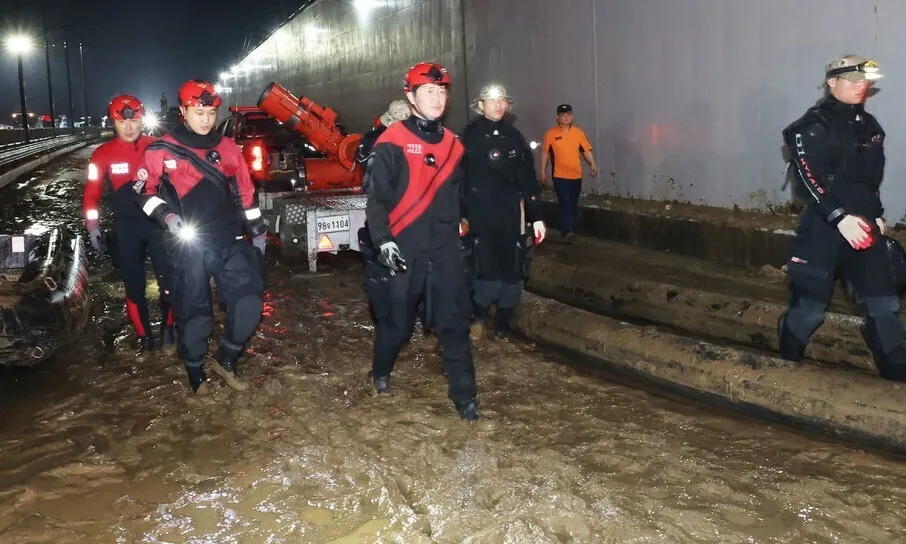hankyoreh
Links to other country sites 다른 나라 사이트 링크
Dayslong downpour in central Korea kills 39, leaves 9 missing

The discovery of three additional bodies in a flooded underpass in Osong, North Chungcheong Province, brought the total death toll in connection with recent torrential rains to 39 as of 6 am on Monday, with another nine people still listed as missing.
The Central Disaster and Safety Countermeasure Headquarters (CDSCH) announced Monday that the death toll associated with the recent heavy rains had risen to 39 as of 6 that morning, including 1 victim in Sejong, 15 in North Chungcheong, 4 in South Chungcheong Province, and 19 in North Gyeongsang Province.
Another nine people were listed as missing (including 1 in Busan and 8 in North Gyeongsang), while 34 injuries were reported (1 in Gyeonggi Province, 13 in North Chungcheong, 2 in South Chungcheong, 1 in South Jeolla Province, and 17 in North Gyeongsang). Those numbers were unchanged from a previous report at 11 pm on Sunday.
Following the CDSCH’s calculation, another body was retrieved from the Gungpyeong No. 2 Underpass in the town of Osong of Cheongju, North Chungcheong, bringing the death toll in connection with the tunnel’s flooding to 13 so far.
The number of people temporarily evacuated was tallied at 10,570 from 6,255 households in 111 cities and counties from 15 metropolitan cities and provinces, with an especially large increase in southern South Korea. Of them, 5,788 from 3,326 households have yet to return home.
Damage to structures and facilities was up sharply in the Chungcheong and North Gyeongsang regions, where rain was especially heavy. The 628 total cases reported included 146 involving road slope loss and collapse; 49 cases involving roads being damaged or destroyed; 108 involving soil loss; 169 involving river embankment loss; 8 involving falling rocks and landslides; 49 involving water supply and drainage damage; and 22 involving the inundation of cultural heritage.
The number was up by 349 cases from the total reported at 11 pm the evening before, with numerous reports from the regions of South Chungcheong (311) and North Gyeongsang (150).
A total of 317 cases of damage to private facilities were reported, including 139 involving residential flooding, 52 involving residential damage, and five cases involving a total of 64 vehicles overtaken by flood waters.
As the rain continued, access to 271 roads nationwide was restricted, along with 853 riverside roads, 256 waterside parking facilities, and 99 forest trails and similar locations. Access was also barred to 489 trails at 19 national parks, including Mount Jiri.
The Gyeongbu, Honam, Jeolla, Gyeongjeon, and Donghae lines of the KTX high-speed railroad remained in service, but service was suspended between Seoul and Busan, and between Yongsan and Mokpo/Yeosu and on the Jungang Line (Eum) and Jungbunaeryuk Line (Eum).
Operation was also halted for all non-high-speed train lines.
As of 9:30 pm on Saturday, recovery efforts had been completed following the derailment of a Mugunghwa train at 10:59 pm on Friday.
By Son Ji-min, staff reporter
Please direct questions or comments to [english@hani.co.kr]

Editorial・opinion
![[Correspondent’s column] Coupang’s game in Washington follows familiar pattern [Correspondent’s column] Coupang’s game in Washington follows familiar pattern](https://flexible.img.hani.co.kr/flexible/normal/500/300/imgdb/original/2025/1226/8217667391873536.jpg) [Correspondent’s column] Coupang’s game in Washington follows familiar pattern
[Correspondent’s column] Coupang’s game in Washington follows familiar pattern![[Editorial] Coupang’s attempt to hide behind US won’t win back Korean consumers [Editorial] Coupang’s attempt to hide behind US won’t win back Korean consumers](https://flexible.img.hani.co.kr/flexible/normal/500/300/imgdb/original/2025/1226/1817667387971465.jpg) [Editorial] Coupang’s attempt to hide behind US won’t win back Korean consumers
[Editorial] Coupang’s attempt to hide behind US won’t win back Korean consumers- Coupang under fire for possible obstruction of investigation into its customer data leak
- [Editorial] Coupang founder’s contempt for workers, customer security knows no bounds
- [Column] Confessions of a Coupang-holic
- [Editorial] Kim Bom-suk’s arrogance on full display in boycott of Coupang leak hearing
- [Editorial] The facts of Yoon’s insurrection are clear — justice cannot be further delayed
- [Column] Trump destroys government
- [Column] A post-Western world approaches
- [Column] Offshore balancing, or carving out spheres of influence?
Most viewed articles
- 1Korea to trial next-gen train capable of sub-2-hour Seoul-Busan trip starting 2030
- 2Kim Jong-un’s hidden motive in criticizing South Korea’s nuclear submarine push
- 3[Editorial] Coupang’s attempt to hide behind US won’t win back Korean consumers
- 4Coupang under fire for possible obstruction of investigation into its customer data leak
- 5[Correspondent’s column] Coupang’s game in Washington follows familiar pattern
- 6Real-life heroes of “A Taxi Driver” pass away without having reunited
- 7Moon Jae-in renews call for end-of-war declaration, peace treaty on Korean Peninsula
- 8Chang Chun-ha’s family hopes to know truth of his death after 37 years
- 9Chinese money flooding into South Korean companies
- 10Russian architect personally witnessed Empress Myeongseong’s assassination by Japanese ronin, accoun